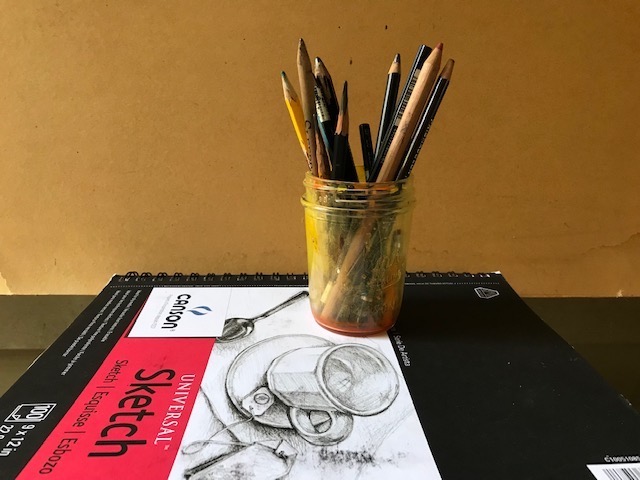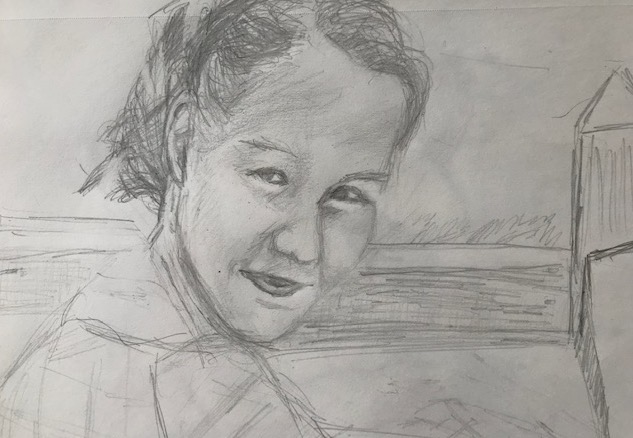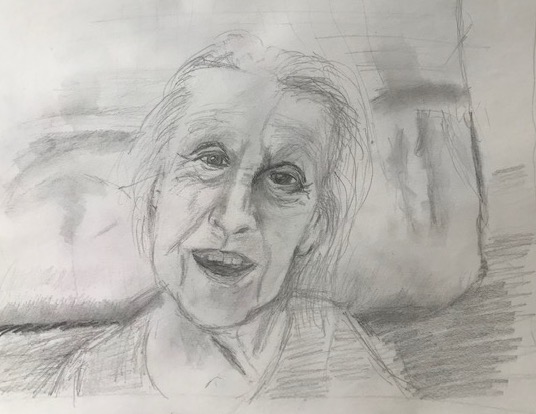
There are many ways to get to know someone, even someone we haven’t met, and this week I’ve been playing with one that has proved particularly meaningful to me.
I draw faces.
We live, or at least I do, in a world of judgments, mental constructs, expectations, and prejudices that influence how we see people around us. Drawing invites us to suspend our judgment and enter the brave new world of observation. Drawing invites us to become curious and see the familiar anew.
If you’re saying, “that’s all good if you can draw,” I beg to differ. You’re reading here the words of someone who would have failed “Stick Figures 101” if there had been such a class. When I was nine, drawing and I had an amicable separation, and I didn’t return to the relationship until I was 68 at the start of the pandemic.
I mention this just in case you are, like I was, draw-a-phobic.
Heather Williams, a wonderful online teacher I have worked with and author of Drawing as a Sacred Activity reinforced the idea put forward by Betty Edwards (Drawing on the Right Side of the Brain) and others that drawing is an activity that one can learn, not a god-given talent that either you have or you don’t. I figured I would be a good test case.
Drawing out beauty
Although I liked to try to draw just about anything, drawing didn’t become exciting until I started drawing faces. I’m always interested in people, and drawing was another way to pursue that interest.
Sadly, in my youth, my notion of who was beautiful (never me) and what was beautiful (not my art, for goodness sake) was corrupted as I looked to the media and advertisers for the standards to follow.
As a child, I didn’t understand that these influencers wanted to sell products, not empower us to discover beauty in the world and ourselves.
Like almost any other red-blooded teenage girl of the early 1960s, I traveled with a list of my flaws in my hip pocket, with a prepared soliloquy I could share with my girlfriends about how I was not who I was supposed to be. I took the source code for fitting in from magazines, TV, and movies: white, fair-haired, able-bodied, thin-nosed, and anorexically thin.
Back then, I thought being beautiful meant fitting a specific look. But as I’ve aged and played with art, I’ve learned true beauty thrives on uniqueness and differences. And each person has the right to decide what is beautiful to them.
Drawing has helped me wake from the trance of cultural stereotyping and stop giving to others my powers of discernment.
Drawing differences
I love drawing people different from me, with varied backgrounds, features, and skin tones.
When I look at someone through the lens of a sketcher, no eyes are too small, no nose too big, and no markings too weird. Atypical facial characteristics are interesting, and a feature that someone else might call ugly becomes an enjoyable challenge to draw.
Whether I like the final sketch I produce or not, the experience of drawing a face expands me. More often than not, I fall in love with that face, and the person behind it, usually a stranger I will never meet.
Sometimes in big Zoom classes, I can secretly draw people without disturbing them. Or, I can pull pictures off the internet to sketch. My subjects fascinate me as I observe their features and try to imagine who they are. Drawing builds interest, empathy, and connection.
Granted, I have never tried sketching a political figure I hated. It might be an interesting experiment to see whether I could drop my judgments and preconceptions and work from my eyes rather than my opinions. Perhaps I’d discover the pain locked in furrowed eyebrows or cosmetically altered faces and develop more compassion. But I haven’t gone there yet.
It’s not about the product
My portraits usually end up with skewed noses, eyes that are not correctly aligned, and the kind of something’s-not-quite-right look you see in the work of amateur artists. But that’s not the point. A world is opening for me.
Before I started drawing, I had never studied an ear, and I still find ears rather odd. But it’s fun to focus on something I have seen all my life and see it anew.
Drawing my concept of an ear differs from drawing an ear; the latter takes careful attention and, in my case, many attempts.
As someone who spends most of her day living in the land of concepts, drawing is a relief. I use the part of my brain that thrives on observation rather than judging.
I won’t say that my drawing today is “good” by someone else’s artistic standard, but it’s the process, the noticing, and the devotion to observing that matters, not the product I produce.Although I must admit that my portraits have improved over time.
Drawing as healing

After sketching other people’s faces, I tried drawing mine, and the process was, surprisingly, healing. As someone who held a point of view about her face and nose for years, drawing became a safe zone where I could become face-neutral and approach my face without judgment, noticing its lines, curves, angles, shapes, and shadows. My nose became a challenge to draw, not a liability.
Then, a miracle happened: I started liking my face. I saw the beauty in its essence. It was interesting, as all faces are. Screw that mine doesn’t look like that of a model for Johnny Walker Red scotch or designer dresses. That’s not my path, anyway.
Drawing the dead
I loved my mother and wanted to know more about her past, especially her childhood, but like many of her generation, she didn’t want to talk about it. Then, about the time I was really interested in her stories, she was gone. I wish I could have known her more.
I found a new way to be in a new relationship with her by sketching her, using a photo of her at nineteen leaning on a fence post. She looked fresh and lovely, even though she might not have seen herself that way.

Drawing her gave me two hours to get to know her younger self and commune with her spirit. My final sketch didn’t quite capture her look, but I hope to set up another encounter soon.
I also drew my mother in her final year, when she could barely communicate. Without her false teeth, her mouth caved in, and her smile changed. As she lay, smiling in bed, she wouldn’t have fit any advertiser’s norm for beauty. But to me, she had never looked more beautiful.

After I had drawn her taut skin, wrinkles, and stringy hair, infusing all I did with love, my view of the elderly changed. Like Mom, elders are beautiful with their marked and well-weathered faces, not in spite of them.
The magic of the pencil is teaching me how to look at a face and see the beauty that is there, somewhere, in everyone.










4 Responses
Wow! While I haven’t tried drawing faces, I’ve tried things more along the lines of coast Salish influence. Might have to add faces to my to do list. I’ve also been sorting through my Mom’s finished and unfinished paintings as we are getting to the final touches of unpacking hanging art. It does allow me to “know” my Mom differently as I see how her art changed over time.
What a beautiful way to know your Mom, Muffy, and how wonderful that you are working with things Salish — such an importance influence on our Northwest lives.
I know your wonderful face an your sketch nailed it! Thanks for your inspirational vulnerability once again Sally.
Love the sketches Sally! Seems like your essence looking out of those eyes, with that smile. More you than a photo-